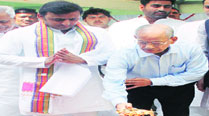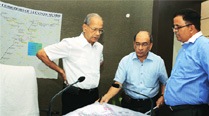 One of Akhilesh’s dream projects, the Lucknow Metro Rail was also part of the budget speech for the year 2013-14.
One of Akhilesh’s dream projects, the Lucknow Metro Rail was also part of the budget speech for the year 2013-14.
The first metro rail in Lucknow will be opened to the public on Wednesday, with the promise of a “cheaper, congestion-free and eco-friendly” ride. Readied in a “record time” of 14 months, and nearly nine months after its trial run, which was flagged off by former Chief Minister Akhilesh Yadav, the 8.5 km long corridor from Charbagh station to Transport Nagar (eight elevated stations) will finally be inaugurated by Union Home Minister Rajnath Singh in the presence of Chief Minister Yogi Adityanath on Tuesday.
One of Akhilesh’s dream projects, the Lucknow Metro Rail was also part of the budget speech for the year 2013-14.
While the trial run for this priority stretch took place in December 2016, it could not be commissioned following pending clearance by the Commissioner of Metro Railway Safety (CMRS), which the corporation finally got recently on August 14.
The Lucknow Metro Rail Corporation (LMRC) was incorporated as a Special Purpose Vehicle under the Companies Act 1956 on November 25, 2013. The foundation stone for phase-1, the North-South Metro Rail Corridor project was laid by Akhilesh on March 4, 2014. The present 8.5 km stretch was identified as a priority corridor of this phase-1 the during previous SP regime with a deadline for completion by December 2016, keeping the 2017 Assembly elections in mind.
Officials claimed actual civil work for this priority corridor was started on September 27, 2014.

Kumar Keshav, managing director, LMRC said that the priority corridor between Transport Nagar and Charbagh is part of a 23 km North-South Metro corridor (with three underground and eight elevated stations), which is being executed by LMRC from Chaudhary Charan Singh Airport to Munshipulia.
“The second proposed corridor, which is 11 km-long (12 stations), is called the East- West corridor, coming under phase 1B of the project,” said Keshav, adding that their focus will now be shifted towards completion of the North-South Corridor with a target to finish it by April 2019.
The Lucknow Metro will also have the “most advanced signaling and train control system”, called Communication Based Train Control System (CBTC), which will enable trains to virtually operate on “driverless” mode.
Keshav told The Indian Express, “At the Mawaiya Railway Crossing, we constructed a special balanced cantilever span of 255 meters. It was a really critical job, which has been executed at a height of 21 meters above ground level, while railway tracks were functional below it,” he said.
“At Awadh Rotary, Lucknow we launched a 60 meter special steel span bridge crossing the rotary over an Ambedkar statue in the middle. This bridge is 13 mts above the ground, connecting both ends of the Metro,” Keshav added. Asked about technological differences between the LMRC and other Metro projects in the country, Keshav said, “We have an LCD-based display system, better communication system, disk brakes for better acceleration and retardation.” He added that LMRC smart cards are more advanced and serve multiple purposes.
The sale of these smart cards, which would each cost Rs 200 (of which Rs 100 is a refundable security deposit), had begun since September 1. LMRC officials could not confirm how many cards have been sold since September 1. “One would able to use the same smart card in other cities of the state, when the Metro comes up there,” said Keshav.
Officials said that to use free WiFi, passengers will have to register their names and phone numbers and would get the password on their phone. “We can use the card holder’s information to understand travelling patterns of passengers and use it for the betterment of our facilities,” said an officer.

